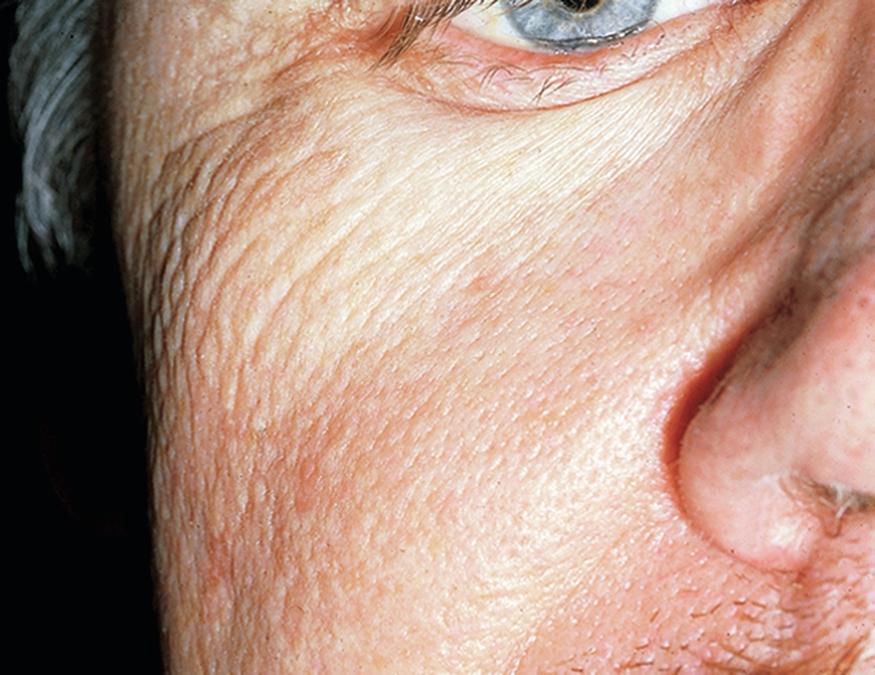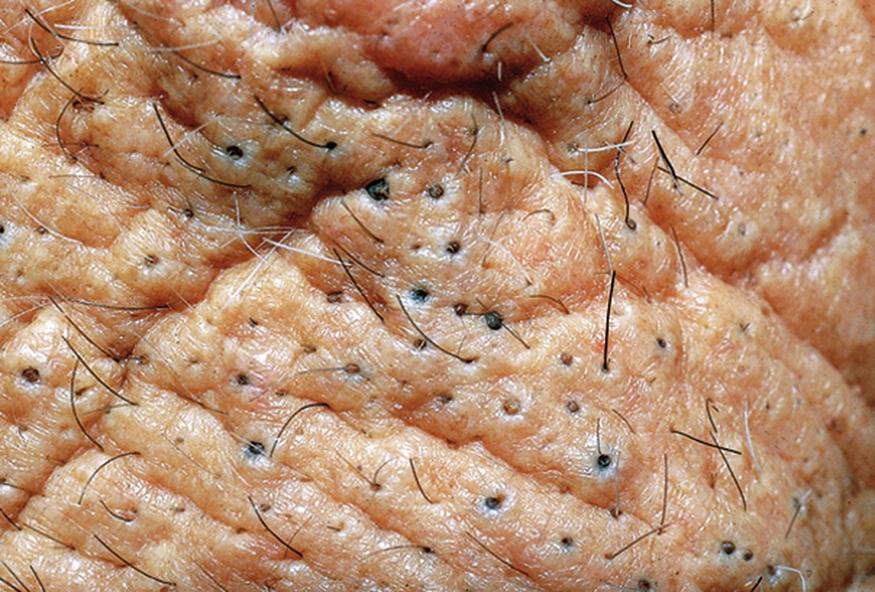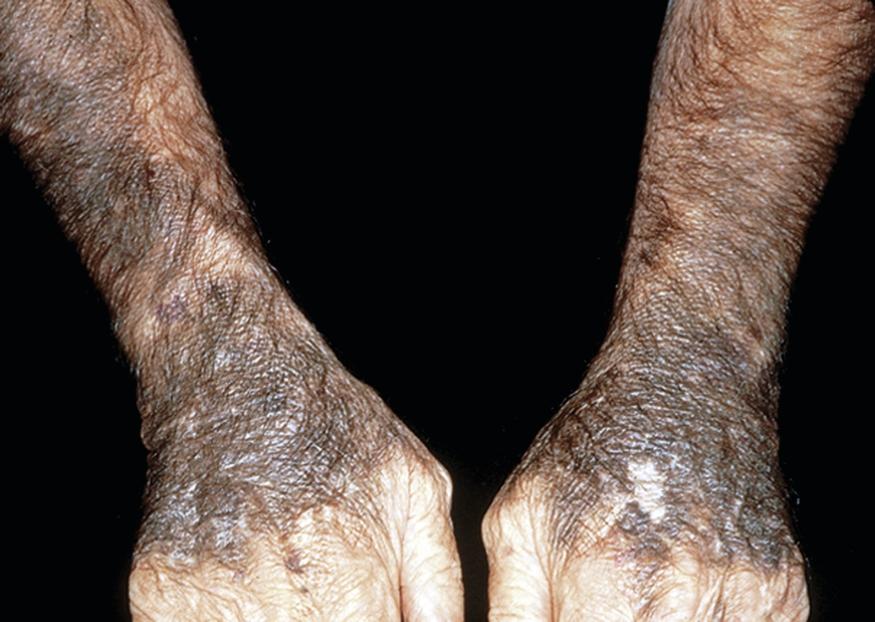Physical Address
304 North Cardinal St.
Dorchester Center, MA 02124
Skin diseases appear more common in the geriatric population than the general population. This may be due to intrinsic skin aging and senescence, immune dysfunction, polypharmacy, and even cognitive and physical impairments that impact personal hygiene. One study revealed that 40% of Americans between the ages of 65 and 74 years had a skin disease significant enough to warrant treatment by a physician. Patients older than 74 years are even more likely to develop significant skin diseases.
Beauregard SA, Gilchrest BA. Survey of skin problems and skin care regimens in the elderly. Arch Dermatol. 1987;123:1638–1643.
Farage MA, Miller KW, Berardesca E, et al. Clinical implications of aging skin: cutaneous disorders in the elderly. Am J Clin Dermatol . 2009;10:73–86.
Aging of the skin is divided into intrinsic aging and extrinsic aging ( Table 58.1 ). Intrinsic aging refers to changes with the passage of time that are due to normal maturity and senescence, and it occurs in all persons. Classically, intrinsic aging was considered unpreventable, but there is renewed interest in the role of antioxidants, such as vitamins C and E, in preventing or slowing intrinsic aging. Research in this area is still in its infancy, and well-designed, controlled long-term studies are still lacking.
| Intrinsic aging | Extrinsic aging (Primarily ultraviolet light) |
|---|---|
|
|
Gragnani A, Cornick S, Chominski V, et al. Review of major theories of skin aging. Adv Aging Res . 2014;3:265–284.
Extrinsic aging of the skin refers to those changes due to external agents. The most important extrinsic factor in aging is cumulative ultraviolet (UV) light exposure. These cutaneous changes caused by sunlight are referred to collectively as dermatoheliosis. Skin aging attributable to UV light includes skin wrinkles, “leathery” skin, thinned skin, dyspigmented skin, telangiectasias, and skin fragility (“tearing” and “solar purpura”). Other extrinsic agents that accelerate aging of the skin include smoking and environmental pollutants.
Bonté F, Girard D, Archambault JC, et al. Skin changes during ageing. Subcell Biochem . 2019;91:249–280.
Under the microscope, aged skin demonstrates a flattening of the dermal–epidermal junction with loss of the normal rete ridge pattern (see Fig. 58.1 A ). There are fewer junctional melanocytes and Langerhans cells. The dermis in aged skin demonstrates fewer fibroblasts, fewer mast cells, fewer blood vessels, depigmentation of hair, loss of hair follicles, and fewer sweat glands.
![Fig. 58.1, A, Severe solar elastosis. The pale, light blue-gray material in the superficial dermis has largely replaced the normal highly eosinophilic collagen bundles. Also note the loss of the normal rete pegs in the epidermis (hematoxylin and eosin [H&E]). B, Cutis rhomboidalis nuchae. Severe solar elastosis and wrinkling of the posterior neck secondary to sun exposure that clearly demarcates from more–normal-appearing skin that is less sun-damaged. Fig. 58.1, A, Severe solar elastosis. The pale, light blue-gray material in the superficial dermis has largely replaced the normal highly eosinophilic collagen bundles. Also note the loss of the normal rete pegs in the epidermis (hematoxylin and eosin [H&E]). B, Cutis rhomboidalis nuchae. Severe solar elastosis and wrinkling of the posterior neck secondary to sun exposure that clearly demarcates from more–normal-appearing skin that is less sun-damaged.](https://storage.googleapis.com/dl.dentistrykey.com/clinical/GeriatricDermatology/0_3s20B9780323673235000581.jpg)
The answer is complicated, because some authorities recognize as many as five different subtypes of wrinkles. Mots wrinkles on photoprotected skin are fine wrinkles (glyphic wrinkles) that represent accentuation of normal skin markings due to focal skin thinning with fewer keratinocytes. This appears to be intrinsic to aging ( Fig. 58.2 ). Deeper wrinkles in photodamaged skin demonstrate a groove in the epidermis that is associated with solar elastosis (solar damaged elastic tissue) that protrudes on both sides of the groove. These deeper wrinkles are due to extrinsic aging, primarily resulting from UV light. The amount of collagen, elastin, and ground substance also decreases in aged skin, and this may contribute to skin wrinkling, as well.

Smoking is an important extrinsic factor that accelerates skin aging. This conclusion is supported by epidemiologic studies, animal studies, and in vitro studies. Biochemically, smoking increases the production of tropoelastin and matrix metalloproteinases that degrade collagen and elastic fibers. This leads to abnormal elastotic material. Avoidance of premature aging is an important reason not to smoke!
Morita A, Torii K, Maeda A, et al. Molecular basis of tobacco smoke–induced premature skin aging. J Investig Dermatol Symp Proc . 2009;14:53–55.
Solar (actinic) elastosis refers to abnormal degradation of elastotic fibers in the shallow due to UV light exposure ( Fig. 58.1 A). These abnormal elastotic fibers are apparent as a blue/grey amorphous material, and these fibers mark with elastic tissue stains. Electron microscopy indicates that these solar damaged fibers are similar, but not identical, to normal elastic fibers. Research suggests solar elastosis is due to ultraviolet A (UVA) damage to fibroblasts that yields overproduction and accumulation of elafin, which binds to elastic fibers, making them resistant to normal degradation by elastase. Clinically, large aggregates of solar-damaged elastic fibers impart a yellow color to the skin of older persons. Solar elastosis is often most easily appreciated in the posterior neck, where it is termed cutis rhomboidalis nuchae ( Fig. 58.1 B).
Pain S, Berthélémy N, Naudin C, et al. Understanding solar skin elastosis-cause and treatment. J Cosmet Sci . 2018;69:175–185.
Favre-Racouchot syndrome is a form of extreme extrinsic skin aging characterized by the presence of marked solar elastosis and comedones on the lateral and inferior periorbital areas ( Fig. 58.3 ). Severe cases may demonstrate cysts. While it is most often due to excessive UV radiation, it has also been associated with smoking and with ionizing radiation. The reason for the regional presentation is not well understood, but it has been suggested that the fibroblasts around the hair follicles are damaged by the radiation and no longer produce normal elastic tissue. This predisposes to dilatation of the hair follicles, resulting in comedones and cysts. Most cases can be successfully treated with topical tretinoin cream and comedonal extraction.

Sutherland AE, Green PJ. Favre-Racouchot syndrome in a 39-year old female following radiation therapy. J Cutan Med Surg . 2014;18:72–74.
Liver spots/age spots are known by the more proper medical terms solar lentigo. Clinically, solar lentigines (plural) are macular (flat), tan to brown lesions located on sun-exposed skin. The dorsum of the hands, forearms, and face are often affected. These lesions having nothing to do with the liver and are instead the result of accumulated UV damage. Under the microscope, solar lentigines demonstrate elongation of the epidermal rete with modestly increased melanocytes at the dermoepidermal junction, which produce excess melanin. Solar lentigines may be removed with a light liquid nitrogen freeze, with chemical peels, with combination 2% mequinol/0.01% tretinoin, or with lasers that treat pigment. Over-the-counter bleaching cream (1%–2% hydroqunione) or prescription (4% hydroquinone) bleaching cream may lighten lentigines, but with modest sunlight they often recur.
Bolognia JL. Aging skin. Am J Med . 1995;98(1A):99S–103S.
These lesions, referred to as solar purpura (Bateman purpura), are common. One study of patients over age 64 years found solar purpura in 9% of patients examined. Solar purpura typically measure 1 to 5 cm and are sharply circumscribed ( Fig. 58.4 ). Solar purpura occurs upon aged skin that is atrophic and inelastic. It is believed the cumulative solar damage leads to a lesser collagenous support around blood vessels, which results in the loss of normal supporting collagen, and minor trauma leads to rupture of the vessels with intradermal hemorrhage. In support of this theory of solar damage, there is often lateralization of solar purpura to the arm that receives more sunlight (e.g., left arm of a taxicab driver).

Joshi RS, Phadke VA, Khopar US, et al. Unilateral solar purpura as a manifestation of asymmetrical photodamage in taxi drivers. Arch Dermatol. 1996;132:715–716.
Become a Clinical Tree membership for Full access and enjoy Unlimited articles
If you are a member. Log in here